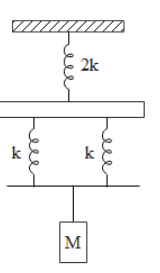
Answer
452.7k+ views
Hint: When springs are connected in parallel then the resultant spring constant is equal to sum of the individual spring constants while in series combination, the net spring constant gets averaged out. The expression for the time period of a spring system can give the answer for this question.
Formula used:
Combinations of springs: If we have two springs of spring constants ${k_1}$ and ${k_2}$ respectively, then in series combination their resultant spring constant is given as
$\dfrac{1}{k} = \dfrac{1}{{{k_1}}} + \dfrac{1}{{{k_2}}}$
In parallel combination, the resultant spring constant is given as
$k = {k_1} + {k_2}$
The time period of oscillations for a spring mass system is given as
$T = 2\pi \sqrt {\dfrac{m}{k}} $
Complete answer:
We are given a spring mass system, with one spring connected in series with a parallel combination of two other springs, their spring constant as shown in the figure. A mass M is suspended from the bottom of the system which makes the system oscillate due to force exerted by the weight of the mass on the system.
The resultant spring constant of two springs connected in parallel to each other is $k + k = 2k$. They are connected in series with upper spring and their resultant is given as
$
\dfrac{1}{{k'}} = \dfrac{1}{{2k}} + \dfrac{1}{{2k}} = \dfrac{2}{{2k}} \\
k' = k \\
$
This is the value of the resultant spring constant of the springs in the system.
Next we know that the time period of oscillations of the spring mass system is given by the following equation.
$T = 2\pi \sqrt {\dfrac{m}{{k'}}} $
Inserting the value of the resultant spring constant, we get that
$T = 2\pi \sqrt {\dfrac{m}{k}} $
Based on the observed values, we can say that the correct answer is option D as none of the other options are correct.
Note:
The spring mass system executes simple harmonic motion. The various springs have different spring constants but as a whole they exhibit properties of a spring with spring constant k only. Another similar system with a single spring of spring constant k will behave the same as this system.
Formula used:
Combinations of springs: If we have two springs of spring constants ${k_1}$ and ${k_2}$ respectively, then in series combination their resultant spring constant is given as
$\dfrac{1}{k} = \dfrac{1}{{{k_1}}} + \dfrac{1}{{{k_2}}}$
In parallel combination, the resultant spring constant is given as
$k = {k_1} + {k_2}$
The time period of oscillations for a spring mass system is given as
$T = 2\pi \sqrt {\dfrac{m}{k}} $
Complete answer:
We are given a spring mass system, with one spring connected in series with a parallel combination of two other springs, their spring constant as shown in the figure. A mass M is suspended from the bottom of the system which makes the system oscillate due to force exerted by the weight of the mass on the system.
The resultant spring constant of two springs connected in parallel to each other is $k + k = 2k$. They are connected in series with upper spring and their resultant is given as
$
\dfrac{1}{{k'}} = \dfrac{1}{{2k}} + \dfrac{1}{{2k}} = \dfrac{2}{{2k}} \\
k' = k \\
$
This is the value of the resultant spring constant of the springs in the system.
Next we know that the time period of oscillations of the spring mass system is given by the following equation.
$T = 2\pi \sqrt {\dfrac{m}{{k'}}} $
Inserting the value of the resultant spring constant, we get that
$T = 2\pi \sqrt {\dfrac{m}{k}} $
Based on the observed values, we can say that the correct answer is option D as none of the other options are correct.
Note:
The spring mass system executes simple harmonic motion. The various springs have different spring constants but as a whole they exhibit properties of a spring with spring constant k only. Another similar system with a single spring of spring constant k will behave the same as this system.
Recently Updated Pages
Who among the following was the religious guru of class 7 social science CBSE

what is the correct chronological order of the following class 10 social science CBSE

Which of the following was not the actual cause for class 10 social science CBSE

Which of the following statements is not correct A class 10 social science CBSE

Which of the following leaders was not present in the class 10 social science CBSE

Garampani Sanctuary is located at A Diphu Assam B Gangtok class 10 social science CBSE

Trending doubts
A rainbow has circular shape because A The earth is class 11 physics CBSE

Which are the Top 10 Largest Countries of the World?

Fill the blanks with the suitable prepositions 1 The class 9 english CBSE

The Equation xxx + 2 is Satisfied when x is Equal to Class 10 Maths

How do you graph the function fx 4x class 9 maths CBSE

Give 10 examples for herbs , shrubs , climbers , creepers

Who gave the slogan Jai Hind ALal Bahadur Shastri BJawaharlal class 11 social science CBSE

Difference between Prokaryotic cell and Eukaryotic class 11 biology CBSE

Why is there a time difference of about 5 hours between class 10 social science CBSE





